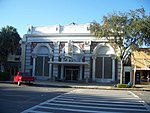Tropicana Field

Tropicana Field (commonly known as the Trop) is a multi-purpose domed stadium located in St. Petersburg, Florida, United States. The stadium has been the ballpark of the Tampa Bay Rays of Major League Baseball (MLB) since the team's inaugural season in 1998. The stadium is also used for college football, and from December 2008 to December 2017 was the home of the St. Petersburg Bowl, an annual postseason bowl game. The venue is the only non-retractable domed stadium in Major League Baseball, making it the only year-round indoor venue in MLB. Tropicana Field is the smallest MLB stadium by seating capacity when obstructed-view rows in the uppermost sections are covered with tarps as they are for most Rays games. Tropicana Field opened in 1990 and was originally known as the Florida Suncoast Dome. In 1993, the Tampa Bay Lightning moved to the facility and its name was changed to the ThunderDome until the team moved to their new home in downtown Tampa in 1996. In October 1996, Tropicana Products, a fruit juice company then based in nearby Bradenton, signed a 30-year naming rights deal. Tropicana Field's location and design (especially the ceiling catwalks) have been widely criticized. Along with Oakland Coliseum, it is often cited as one of the worst ballparks in Major League Baseball. Major League Baseball has cited the need to replace Oakland Coliseum and Tropicana Field as one of the primary obstacles to future MLB expansion.In 2023, the Tampa Bay Rays announced a deal with local politicians to build a new stadium near Tropicana Field at an expected cost of $1.2 billion, half of which would fall on taxpayers. The St. Petersburg City Council blocked a proposal to allow St. Petersburg citizens to express their view on the stadium subsidy in an advisory referendum.
Excerpt from the Wikipedia article Tropicana Field (License: CC BY-SA 3.0, Authors, Images).Tropicana Field
Pinellas Trail, Saint Petersburg
Geographical coordinates (GPS) Address Nearby Places Show on map
Geographical coordinates (GPS)
| Latitude | Longitude |
|---|---|
| N 27.768333333333 ° | E -82.653333333333 ° |
Address
Tropicana Field
Pinellas Trail
33701 Saint Petersburg
Florida, United States
Open on Google Maps








